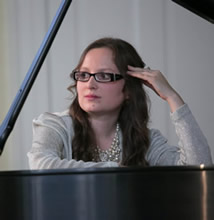No musical organization in the Triangle – and probably no ensemble in the entire state – has done better than the Hillyer Community Chorus when it comes to presenting unknown or rarely-heard works. For longer than we’ve been writing reviews, Conductor (and musicological sleuth) Paul Conway and, without doubt, some of his devoted singers have been scouting the world’s libraries and archives for forgotten or neglected choral music, securing copies and giving, on average, two concerts per season. This year’s first program, heard on the afternoon of December 9 in Raleigh’s Hillyer Memorial Christian Church, departed from the norm by starting with a well-known mainstream work. Soloist Brent Smith was in excellent form as he navigated the solo part of Mozart’s Clarinet Concerto and managed to keep his cool as the accompanying ensemble lurched through its paces. Time is always the enemy when concerts are being prepared, and the clock is sometimes particularly cruel when orchestral players are brought in at the last minute for one rehearsal and the concert itself.
The program then jumped back a century to feature a Magnificat for five soloists, double chorus, chamber orchestra and organ by French composer Henry Du Mont (1610-84). The featured singers were Mary Kathryn Walston, Marilyn Rogers, James Farlow, Greg Honeycutt, and James H. Edwards. The piece consumes about thirteen minutes and is distinguished by attractive alternations in solo and choral sections. The chorus sang boldly and the soloists were all more than acceptable, although the tenor part seemed to tax Farlow from time to time. The orchestra was weak but rarely played as poorly as it had in the Mozart.
Du Mont’s Magnificat is subtitled “Motet for Two Choirs for the Chapel of the King,” and the afternoon’s major work, a short Mass (“Gaudete in Domino Semper”), was likewise written for France’s royalty–in this case, for the June 11, 1775, coronation of Louis XVI. Composer François Giroust (1737-99) was a competent craftsperson who did extremely well for himself until the Revolution; he switched sides then and survived but like many others fell on hard times, financially. When his Coronation Mass was written, however, he was probably at the height of his creative powers. The work, which is in fact a Missa brevis (or Messe brève), was apparently not rediscovered until 1953. It sets the essential components of the Mass–Kyrie, Gloria, Credo, Sanctus and Agnus Dei–and concludes with a brief “Salvum fac regem.”
It’s amusing to ponder how Giroust might have interacted with the soon-to-be-King as the coronation was planned. “Now François,” Louis might have said, “Let’s get this over with promptly. Give me all the requisite words but don’t gum it up with too many musical frills, and whatever you do, don’t let the tenor have a big solo! It’s a long ceremony, you know, and the focus must be on ME….”
Although Giroust’s Mass is refreshingly short, it is hardly short on innovative treatments of the texts. Six soloists–the aforementioned five plus soprano Deborah Ballard–did the honors in Raleigh, and they and the chorus gave a bold account of the music, which would surely have filled the Cathedral at Rheims (the coronation site) to overflowing. The composer’s ingenuity was particularly evident in a series of numbers for the soloists, not all of whom he used every time. There was great contrast between these sections and the passages sung by the full choir. The work’s brevity apparently ensured that the entire thing was performed at the coronation.
At Hillyer, the choir, standing forward of the orchestra, tended to obscure the instrumental contributions, which nonetheless emerged from time to time as the score unfolded. This work seems to be a major discovery, one that gives considerable pleasure to listeners and must surely have been fun to sing. Conway hasn’t made a habit of repeating his finds, but this one would be worth an encore performance at some point.
*****
For the following note on the concluding section of this Mass, I am indebted to our colleague Marvin J. Ward, who could not review the performance because he sang in it:
“There is no doubt whatsoever that this text (‘Salvum fac regem,’ from Ps. 20:10 or Ps. 19:10, in the Vulgate) and the first music to which it was set (by Jean-Baptiste Lully) is the origin of ‘God Save the King,’ generally attributed to Thomas Arne. Lully himself used the English words and his own music at Versailles, to honor the visiting King of England, who then took it back to England. Because I’ve never seen the score, I’m not certain whether the original music is that which is still used or whether there have been some subsequent adaptations, but my understanding is that it’s still Lully’s tune–and that tune is of course the same as our presidential ‘Hail to the Chief.’ The tune was originally composed for Louis XIV, of course, not for the English visitor, and it rapidly became customary for it to be played at any mass or event at which the king was present, to conclude a mass, or to announce the king’s arrival at a public event, whenever he actually arrived–thus interrupting the proceedings!”
*****
Conway will lead the Hillyer Community Chorus in the US premiere of J.D. Bomtempo’s Requiem on May 19.











